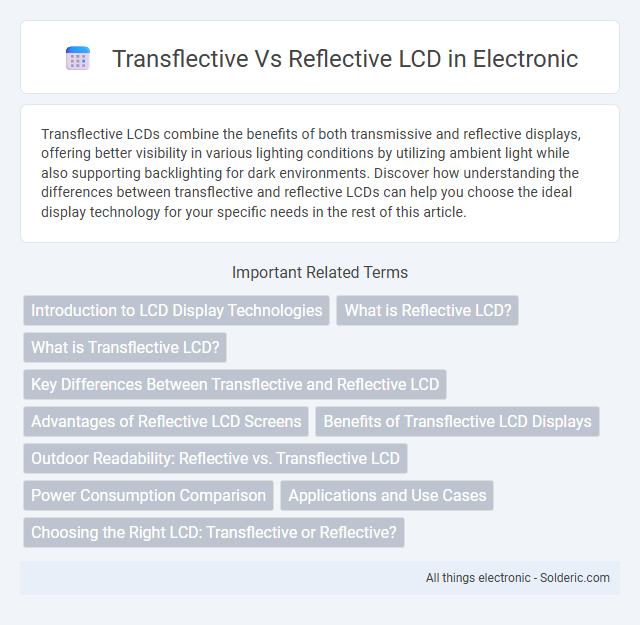Transflective LCDs combine the benefits of both transmissive and reflective displays, offering better visibility in various lighting conditions by utilizing ambient light while also supporting backlighting for dark environments. Discover how understanding the differences between transflective and reflective LCDs can help you choose the ideal display technology for your specific needs in the rest of this article.
Comparison Table
| Feature | Transflective LCD | Reflective LCD |
|---|---|---|
| Display Type | Combines transmissive and reflective modes | Reflects ambient light only, no backlight |
| Visibility | Good visibility in bright and low light | Best in bright ambient light |
| Backlight | Uses backlight for low-light conditions | No backlight; depends on ambient light |
| Power Consumption | Moderate power use due to backlight | Very low power consumption |
| Use Cases | Outdoor and indoor devices needing versatility | Devices designed for bright environments |
| Cost | Higher due to complex design | Lower, simpler technology |
Introduction to LCD Display Technologies
Transflective and reflective LCD display technologies differ primarily in their interaction with ambient light to enhance visibility. Reflective LCDs utilize ambient light that passes through the display and reflects off a mirrored back layer, resulting in better visibility in bright environments without backlighting. Transflective LCDs combine transmissive and reflective properties, incorporating a partial reflective layer that allows the display to operate efficiently in both low-light and bright conditions, optimizing power consumption and readability.
What is Reflective LCD?
Reflective LCD uses ambient light reflected from a mirror-like backing to illuminate the display, enhancing visibility in bright environments without a backlight. This technology consumes less power compared to transmissive LCDs since it relies on external light sources. Reflective LCDs are ideal for devices used outdoors or in high-light conditions, offering superior readability and energy efficiency.
What is Transflective LCD?
Transflective LCD is a display technology combining transmissive and reflective properties, allowing screens to be visible in both bright sunlight and low-light conditions. It utilizes a partially reflective layer behind the liquid crystals to reflect ambient light while also permitting backlight illumination for darkness. This hybrid approach enhances readability and energy efficiency compared to purely reflective or transmissive LCDs.
Key Differences Between Transflective and Reflective LCD
Transflective LCDs combine transmissive and reflective properties, using ambient light to enhance visibility while maintaining backlight use for low-light conditions. Reflective LCDs rely solely on ambient light by reflecting it back to the viewer, making them highly energy-efficient but less effective in dark environments without illumination. The key difference lies in their performance across lighting conditions: transflective screens adapt to various environments, whereas reflective screens excel primarily in bright, well-lit settings.
Advantages of Reflective LCD Screens
Reflective LCD screens offer superior visibility in bright environments by utilizing ambient light, which reduces power consumption compared to backlit displays. Their high contrast ratio enhances readability under direct sunlight, making them ideal for outdoor applications such as smartwatches and portable devices. The absence of backlight also contributes to thinner, lighter designs, increasing durability and energy efficiency.
Benefits of Transflective LCD Displays
Transflective LCD displays offer superior visibility in both bright sunlight and low-light conditions by combining transmissive and reflective properties, making them ideal for outdoor applications. Their energy efficiency reduces power consumption since the display can utilize ambient light rather than relying solely on backlighting. Enhanced readability and lower glare improve user experience in diverse environments, contributing to longer battery life in portable devices.
Outdoor Readability: Reflective vs. Transflective LCD
Transflective LCDs enhance outdoor readability by combining transmissive and reflective properties, using ambient light to illuminate the display while maintaining backlight functionality in low-light conditions. Reflective LCDs rely solely on ambient light, offering excellent visibility under bright sunlight but poor performance in dim environments. Transflective displays provide a balanced solution, ensuring clear visibility across varying lighting conditions, making them ideal for devices used both indoors and outdoors.
Power Consumption Comparison
Transflective LCDs consume less power than reflective LCDs in environments with a mix of ambient and artificial light, as their partial backlight reduces the need for high brightness levels. Reflective LCDs rely entirely on ambient light, resulting in near-zero power use for the display but may require higher power for backlighting in low-light conditions. Overall, transflective LCDs balance power efficiency and readability, making them suitable for devices with variable lighting and moderate battery life demands.
Applications and Use Cases
Transflective LCDs excel in environments requiring readability in both bright sunlight and low-light conditions, making them ideal for outdoor devices like GPS units, smartwatches, and industrial instrumentation. Reflective LCDs are best suited for applications where consistent visibility in bright ambient light is critical, such as e-readers and digital price tags. Both display types optimize energy efficiency, with transflective panels offering greater versatility across varying lighting scenarios.
Choosing the Right LCD: Transflective or Reflective?
Transflective LCDs combine transmissive and reflective properties, providing better visibility in both bright sunlight and low-light conditions, making them ideal for devices used indoors and outdoors. Reflective LCDs rely solely on ambient light, offering excellent readability in direct sunlight but typically require external backlighting in darker environments. Selecting the right LCD depends on the primary usage scenario, with transflective displays preferred for versatile lighting conditions and reflective displays suited for consistently bright settings.
Transflective vs Reflective LCD Infographic

 solderic.com
solderic.com